Do you often wonder Why Do Cats Paw At Your Face? At solcat.net, we understand the curious behaviors of our feline friends. It’s often their way of communicating, showing affection, or simply seeking attention. Let’s explore the most common reasons behind this intriguing behavior, helping you strengthen your bond with your beloved cat. Understanding this behavior can also improve your pet parenting experience and deepen your understanding of feline communication.
1. The “Hey, Listen!” Hypothesis – My Cat Wants My Attention
Is your cat seeking your attention? One of the most straightforward explanations for why your cat paws at your face is that they want your attention. Just like humans, cats use touch as a primary way to communicate their needs and desires.
When a cat wants something, they might start with a meow. If that doesn’t work, they might move closer to you, ensuring they’re in your line of sight, and meow again. If you still don’t respond, they might climb onto you to grab your attention more assertively.
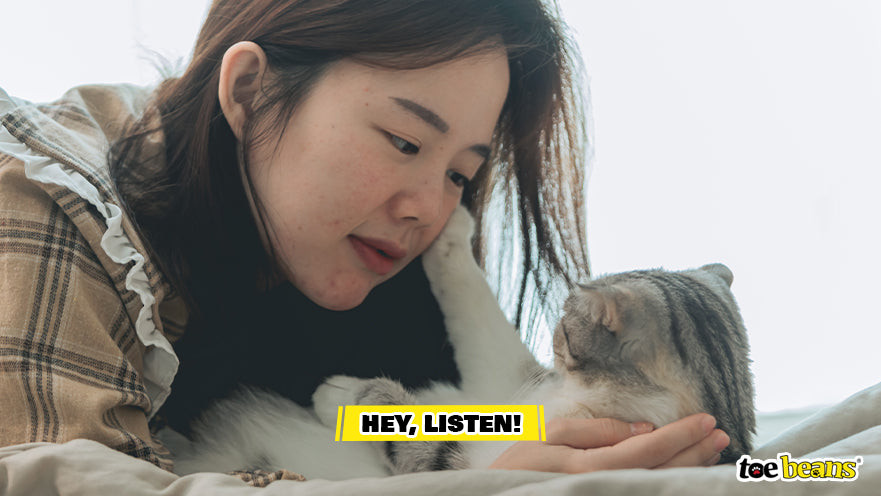 Cat Getting Owners Attention
Cat Getting Owners Attention
Alt text: Cat gently tapping owner’s face to get their attention while they are sleeping.
Tapping your face with their paw is an effective way to get your undivided attention, even if your initial reaction is a bit negative. Sometimes, cats might even bite or lick you to emphasize their need for attention. The key is to understand why they want your attention. Are they hungry and want to be fed? Do they want cuddles or playful interaction? It’s up to you to decipher their specific needs. According to a study by the American Animal Hospital Association (AAHA), understanding your cat’s cues is crucial for maintaining a healthy and happy relationship.
What to do:
- Respond calmly and positively to your cat’s attention-seeking behavior.
- Try to figure out what your cat wants – food, play, or affection.
- Establish a routine so your cat knows when to expect attention.
2. The “You’re Mine” Hypothesis – My Cat Is Claiming Me
Do cats mark their territory? Cats use scent marking to claim ownership, and that includes you. While we often associate scent marking with dogs and their powerful noses, cats also rely on their sense of smell to mark their territory and belongings.
Cats have several ways of scent marking, including spraying, which is primarily used to mark territory. Fortunately, spaying or neutering and training can help prevent this unwanted behavior. Another common method is rubbing their face against you. When your cat rubs their cheeks against you, they’re depositing their scent, marking you as part of their territory.
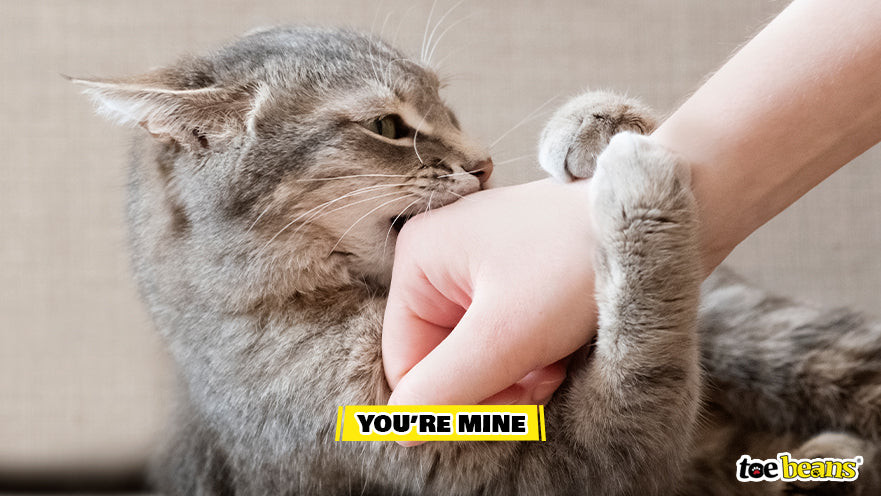 Cat Marking Owner With Their Scent Image by Toe Beans
Cat Marking Owner With Their Scent Image by Toe Beans
Alt text: Close-up of a tabby cat rubbing its face affectionately against its owner’s cheek, transferring its scent.
Paw taps are another subtle way cats mark you. Cats have scent glands on their paws that excrete small amounts of oil and pheromones, leaving a faint trail wherever they walk. By gently touching your face with their paws, they are marking you as their human.
This behavior is often more pronounced in multi-cat households, where cats compete to keep you marked as theirs. This can be a heartwarming sign of their affection and possessiveness.
What to do:
- Allow your cat to rub against you and tap you with their paws.
- Avoid using harsh chemicals on your skin that might mask their scent.
- Provide scratching posts so your cat can mark their territory appropriately.
3. The “I Love You” Hypothesis – Is My Cat Showing Affection?
Is pawing a sign of affection in cats? Absolutely! Your cat tapping your face with their paw can be an expression of love and affection. This is a common hypothesis among cat parents, who hope to see this behavior as a sign of their cat’s deep connection.
Cats often snuggle up to you, gently tap you, or place a paw softly against your cheek, leaving it there. They find comfort in feeling your breath, experiencing your warmth, and sharing your space.
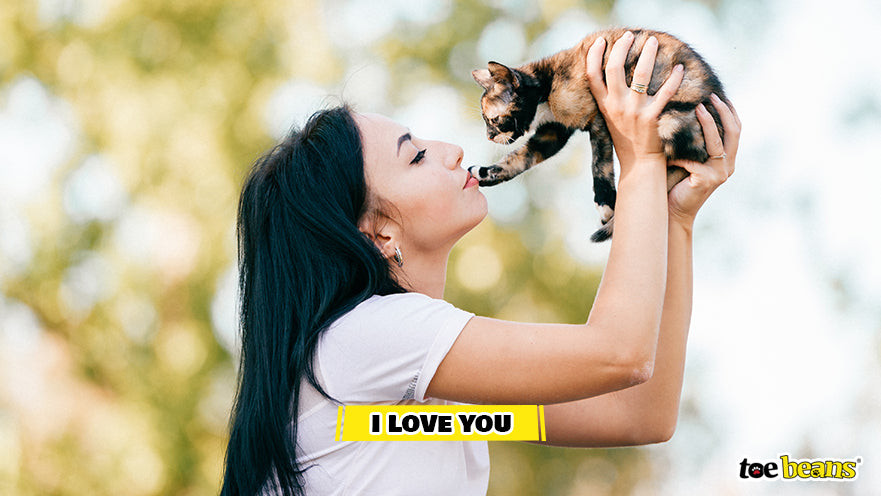 Cat Tapping Owner
Cat Tapping Owner
Alt text: A ginger cat gently placing its paw on its owner’s face while they are lying down, showing affection.
The key is the gentleness of the touch. If the touch is soft, gentle, and without claws, it’s a good sign. If they’re using their claws, they might want something else, or their body language may indicate a different intention.
Look for other signs of affection, such as a relaxed tail curled around them or draped over your arm, slow blinks, and purring. These are all signs that your cat is comfortable and affectionate.
However, it’s important to approach this interpretation objectively. The question of whether cats actually feel love is still debated in the scientific community. Dr. Stacy Choczynski Johnson, DVM, notes that we cannot get into the brains of cats to know if they feel love. However, many experts believe that cats do show affection to their humans.
Jessica Pierce, Ph.D., writes in Psychology Today, “There’s a misconception about cats not showing love to their owners, whereas dogs are very affectionate and demonstrate this love in various ways. But cats do actually show love and affection to their humans.”
Kristyn Vitale, a cat researcher at Unity College, points out that love is a complex concept that isn’t easy to quantify, even in humans. Despite the scientific debate, many cat owners believe that their cats show love through their actions.
What to do:
- Observe your cat’s body language to confirm signs of affection.
- Respond with gentle petting, soft words, and cuddles.
- Continue to nurture the bond you share with your cat through positive interactions.
4. The “Wake Up!” Hypothesis – Is My Cat Trying to Wake Me Up?
Is your cat trying to wake you up? Another likely reason why your cat might paw at your face is that they want you to wake up. This is especially true if they associate you waking up with getting fed or having their needs met.
If it’s time for breakfast and you’re still asleep, your cat might see it as an act of audacity. They might tap your face repeatedly until you wake up and feed them. This behavior typically occurs when you’re in bed or dozing on the couch.
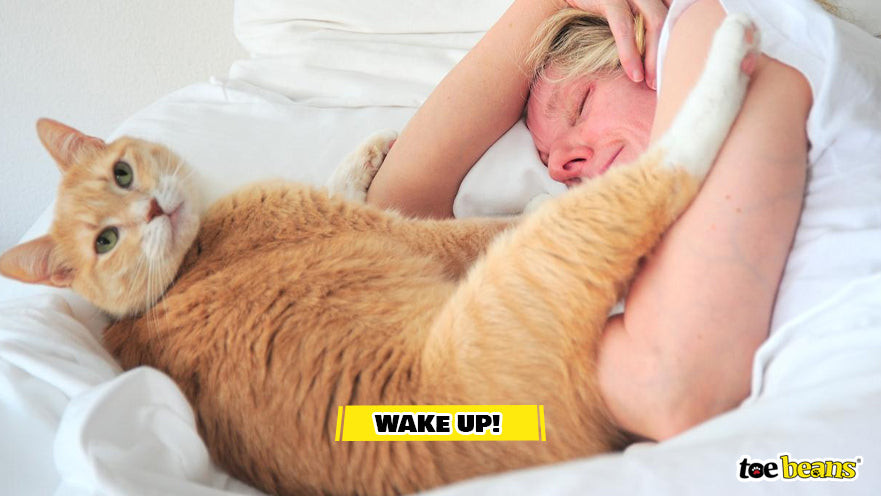 Cat Waking Up Their Owner Image by Toe Beans
Cat Waking Up Their Owner Image by Toe Beans
Alt text: A fluffy cat gently tapping its owner’s forehead in the morning to wake them up.
If you’re a deep sleeper, meowing or knocking things over might not be enough to stir you. So, they might resort to something more direct, like tapping your face, to get a reaction. Some cats might stand on your chest and meow in your face or pounce on your toes.
In some cases, this behavior can be unintentional. The cat might just be playing, but once you’re awake, they realize they can get food or attention. This creates a cat-human training loop, where the cat learns that touching your face leads to a desired outcome.
For example, if your cat touches your face while you’re asleep and you feed them, they might remember the positive outcome and repeat the behavior. This is because cats have both intentionality and memory.
As an example, one cat owner shared that their cat, Moo, would box empty box flaps. The owner started giving Moo food when he boxed, and Moo quickly learned that boxing meant he would get a snack.
What to do:
- Establish a consistent feeding schedule to prevent your cat from waking you up for food.
- Ignore the behavior initially, so your cat doesn’t associate pawing with getting attention.
- Use an automatic feeder if necessary.
5. The “Come Play With Me!” Hypothesis – Is My Cat Bored?
Is your cat looking for a playmate? Cats are natural predators and need to satisfy their prey drive through hunting and play. If they don’t have enough stimulation, they might try to initiate play with you by pawing at your face.
Sometimes, this means leaping for lights or chasing moths. Other times, they rely on you to provide interactive play. When they’re feeling frisky and want to play, they’ll seek your attention.
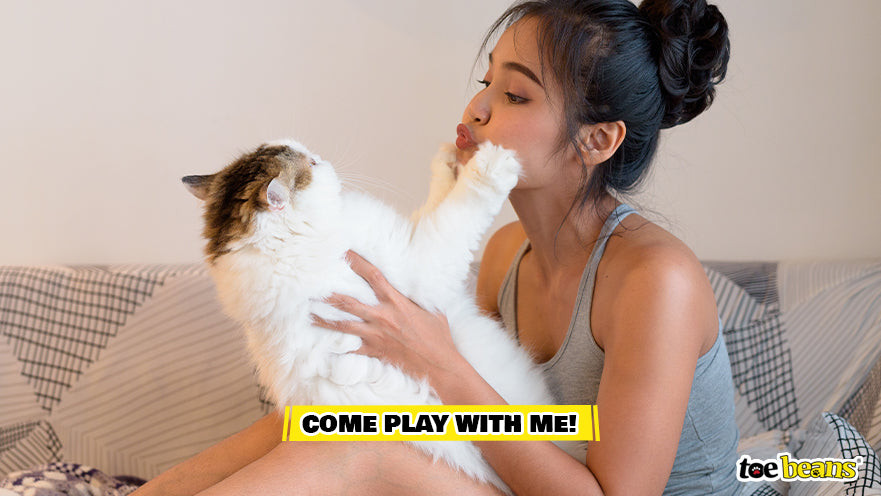 Cat Playing With Their Owner Image by Toe Beans
Cat Playing With Their Owner Image by Toe Beans
Alt text: Owner playfully interacting with their cat, who is reaching out with its paw during a game.
Unlike other attention-seeking behaviors, this one is often accompanied by playful body language. They might lightly swat at you or play with a stray tuft of hair. In some cases, they might even give you playful nibbles.
Cats need daily exercise and mental enrichment. If you’re away at work all day, make sure to engage in a 20- to 30-minute play session when you get home. This can help reduce their need to seek attention through pawing.
What to do:
- Provide plenty of toys and opportunities for play.
- Engage in interactive play sessions with your cat daily.
- Use toys that mimic prey, such as feather wands or laser pointers.
6. The “Back Off, Bud” Hypothesis – Is My Cat Setting Boundaries?
Is your cat asking for space? While most reasons for a cat pawing at your face are signs of affection or attention-seeking, sometimes it’s a way for your cat to set boundaries. If you’re invading their space or doing something they don’t like, they might use their paw to push you away.
If you keep picking them up and nuzzling them when they don’t enjoy it, or if you’re generally irritating them, they’ll eventually get tired of it. At first, they might squirm or try to leave, but if you persist, they’ll put a paw firmly in your face to push you away.
 Cat Irritated With Owner Image by Toe Beans
Cat Irritated With Owner Image by Toe Beans
Alt text: A cat pushing its owner’s hand away with its paw, indicating that it doesn’t want to be touched.
This is often a warning sign. If you continue, they might resort to using their claws. It’s a reminder that while they are cuddly, they are also predators with sharp claws.
It’s usually clear when you’re pushing their boundaries. However, even if you’re not aware of crossing the line, it’s a mistake you’ll likely only make once. The biggest issues will be the wounds to your face, the damage to your pride, and the potential harm to your bond with your cat.
One cat owner shared that their cat, Sosa, couldn’t be picked up without snarling. They worked on picking her up and immediately putting her down to help her understand that nothing bad would happen. Eventually, she became less afraid and allowed herself to be held for longer periods. However, one day, the owner held her a little too long, and Sosa cut through their lip with her claw. This was a clear lesson to listen to the cat’s body language.
What to do:
- Pay attention to your cat’s body language to recognize when they’re uncomfortable.
- Respect their boundaries and give them space when they need it.
- Avoid forcing interactions that they don’t enjoy.
7. The “I Can Do That Too!” Hypothesis – Is My Cat Mimicking Me?
Is your cat copying you? Another reason why your cat touches your face is that they’re mimicking your actions. This could be because you touch your own face, the faces of your loved ones, or even their face.
Science used to believe that only primates and dogs engaged in communal mimicry. Dogs are known for mimicking the actions of their owners. Cats, on the other hand, were often assumed to be aloof and independent.
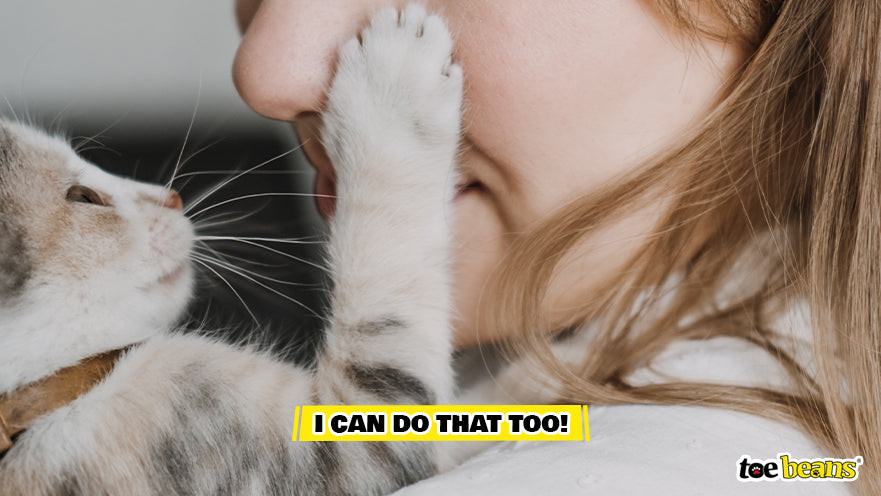 Cat Mimicking Their Owner Image by Toe Beans
Cat Mimicking Their Owner Image by Toe Beans
Alt text: A cat observing its owner touching their face and subtly mimicking the gesture.
However, cats are more observant than we often give them credit for. Some cats mimic small actions you take, subtly enough that you might not even notice it. Others are more pronounced about it.
One famous example is Ebisu, a Japanese cat who loved treats so much that she snuck into dog training classes and learned to mimic her human. Ebisu’s behavior upended the field of animal cognition science.
Check out Ebisu in this 3-minute video: Do as I do in a Cat
Since cats enjoy cheek scratches, it’s possible they believe you enjoy them too and are simply trying to reciprocate.
What to do:
- Be aware of your own behaviors around your cat.
- Encourage positive mimicry by rewarding them when they mimic good behaviors.
- Continue to provide loving interactions, such as cheek scratches.
8. The “Cute Oooh, Big Stretchy!” Hypothesis – Is My Cat Just Being Clumsy?
Is your cat simply stretching? While it’s nice to think that every action your cat takes has a deeper meaning, sometimes they’re just being clumsy. Cats are clever, but they’re not perfect.
Sometimes, they’re just stretching or making biscuits and misjudge the space they’re in, accidentally shoving a paw in your face.
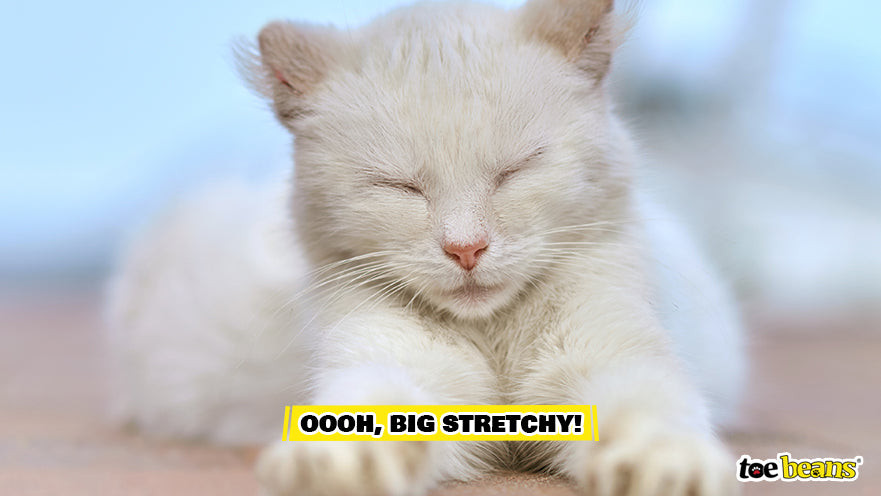 A Cat Stretching Image by Toe Beans
A Cat Stretching Image by Toe Beans
Alt text: A cat stretching its front legs and paws, possibly leading to an accidental poke to its owner’s face.
It might be unpleasant to have a paw in your nose or eye, but they got a good stretch out of it and likely curled back up to keep dozing on your chest. No harm, no foul.
Sometimes, your cat sticks their paws in weird places simply because it’s an accident. They didn’t intend to poke you, but they’re not going to stop because they’re comfortable and they like you.
What to do:
- Be understanding of your cat’s occasional clumsiness.
- Redirect their stretching to a safer area if necessary.
- Continue to provide a comfortable and loving environment.
Is This Bad Behavior?
Should you discourage your cat from pawing at your face? Knowing why your cat touches your face is one thing, but deciding whether to train them out of it is another. You can train them if you know what you’re doing and have the right treats on hand. The question is, should you?
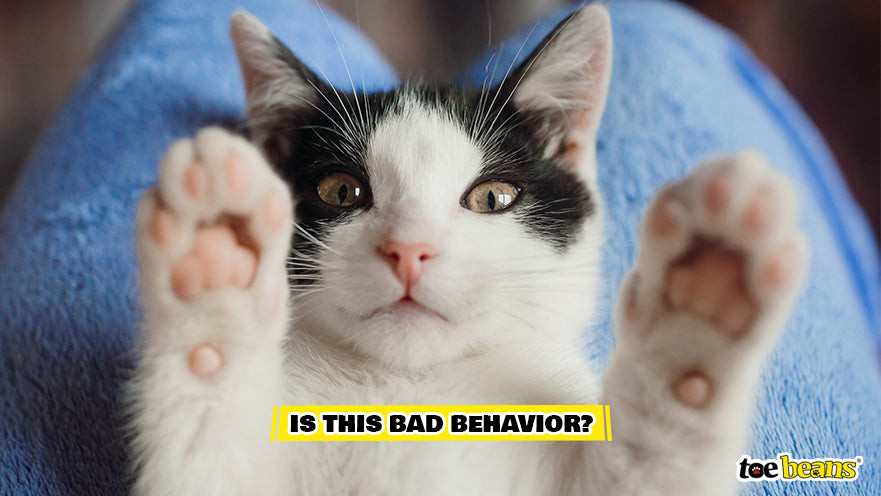 A Cat Holding Out Their Paws Image by Toe Beans
A Cat Holding Out Their Paws Image by Toe Beans
Alt text: Cat gently holding out its paws, looking cute and innocent, but ready to playfully touch or tap.
Generally, it’s up to you. Unless they’re especially careless or your face is especially sensitive, you’re probably fine letting them do what they want to do. Since so many of the reasons they touch you are rooted in affection and bonding, you don’t want to remove those avenues. At most, you want to redirect them. Train them to touch your arm rather than your face, for example.
The biggest risk is disease. Cats are fastidious, but they’re also animals. They clean themselves by licking, and their tongue isn’t sterile. Usually, you’ll be fine, but if your cat is prone to sticking a paw in your mouth, nose, or eyes, or if they accidentally scratch you, it’s not ideal.
Otherwise, just enjoy the love they’re sharing with you.
What to do:
- Assess the behavior based on your comfort level and the cat’s intentions.
- Redirect the behavior if necessary, rather than punishing it.
- Maintain good hygiene practices to minimize the risk of disease transmission.
Enrich Your Cat’s Life with Solcat.net
At solcat.net, we understand the unique bond you share with your cat. That’s why we provide reliable and up-to-date information to help you care for your feline friend. Whether you’re looking for advice on cat behavior, health, or nutrition, solcat.net is your go-to resource.
Explore our articles, images, and videos to deepen your understanding of cats and enhance your pet parenting journey. Join our community of cat lovers in the USA and discover the joy of a well-cared-for and happy cat.
Visit solcat.net today to explore more information and connect with a community of cat enthusiasts. For more information, you can reach us at:
- Address: 950 Alaskan Way, Seattle, WA 98104, United States
- Phone: +1 (206) 386-4000
- Website: solcat.net
Frequently Asked Questions (FAQ)
1. Why does my cat paw at my face while I’m sleeping?
Your cat might be trying to wake you up for food, attention, or play. They might have learned that pawing at your face gets a reaction.
2. Is it normal for cats to touch your face with their paws?
Yes, it is a common behavior. It can be a sign of affection, attention-seeking, or boundary setting.
3. How can I stop my cat from pawing at my face?
Redirect the behavior by offering a toy or gently moving their paw to your arm instead. Ensure they have enough playtime and attention during the day.
4. What does it mean when my cat gently places their paw on my face?
This is often a sign of affection. They are showing that they feel comfortable and close to you.
5. Why does my cat’s paw feel rough when they touch my face?
Cats have rough, textured tongues and paws, which helps them groom and grip surfaces.
6. Is it safe to let my cat touch my face with their paws?
Generally, it is safe, but be mindful of hygiene. Wash your face if they have been outside or if you have any open wounds.
7. Do all cats paw at their owner’s faces?
No, not all cats exhibit this behavior. Each cat has its own unique personality and ways of showing affection.
8. Why does my cat knead my face with their paws?
Kneading is a sign of comfort and contentment, harking back to their kittenhood when they would knead their mother to stimulate milk flow.
9. What should I do if my cat scratches my face while pawing?
Clean the scratch thoroughly with soap and water. Monitor for any signs of infection.
10. Can a cat’s pawing behavior be a sign of a medical issue?
In rare cases, excessive or unusual pawing could indicate a neurological issue. Consult with your vet if you’re concerned.
This comprehensive guide, brought to you by solcat.net, aims to help you understand and appreciate the unique ways your cat communicates.
